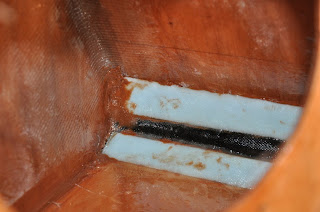Rudders, Prop Shaft and a LittleTesting




The propeller hub from Rick arrived in the mail from Australia on Monday, the day after the Commencement Bay Race. It looked much like I expected, and pretty close to the drawing that the local machine shop came up with after examining my hand-drawn scribble.
Here is a picture of it alongside the bushing Rick also sent. This is the piece that is used to keep the shaft from dropping too deep when the boat is not traveling forward.
Since then I've sealed the control arms of the rudders and wrapped them in 4 oz cloth. It took a lot longer to get the cloth right on the arms as it just didn't want to wrap around and stay flat. I ended up using shrink wrap plastic and a couple of spring clips to reduce the bubbles to a minimum.


Since the screws used to secure the cheeks (pulleys) to the boat need something a bit more substantial than mere 4mm of plywood, I added another layer of plywood covered by some 4 oz cloth. The screws will still penetrate into the hull, but they should be fairly well secured by the extra thickness.
The cheeks are used with a cord to pull down the control arms and deploy the rudders. They are plastic wheels with stainless steel bearings, secured with a fairly lightweight stainless bracket and stainless wood screws.

For the propeller shaft I cleaned the 3/8 inch stainless rod and abraded the 4 or 5 inches near one end with the sanding drum of the Moto-tool. I also tried to clean and abrade the inside of the stainless 5/8 ID tubing that will be the part of the shaft that reaches from the gearbox through the stuffing box to the where the shaft emerges underwater.
I wrapped the rod with 4 oz glass that was about 4 inches wide and then saturated it with resin. In retrospect it might have been better to have saturated the cloth first and then wrapped the rod, as it took a lot of massaging the resin into the dry cloth before the resin made it down to metal. After a while, it seemed to be fairly well saturated, but a bit lumpy.

So, after partially rewinding the cloth back on the rod I began inserting the cloth covered end into the waiting stainless tube. Of course, it only went so far and then the cloth bunched up. From here on I slowly rotated the seamless steel tube over the glass covered rod, applying gentle force to insert the rod into the tube. This seems to have worked quite well, as the further the rod was inserted the more the tube had to get inline with the rod.
After several inches of rod and glass were inserted I then wrapped the outside with more glass and resin.
Finally, I took a long strip of shrink wrap plastic and wrapped it over the outer glass and resin to smooth it out and to help force the resin into the cloth.
After all this was done I noticed that a bunch of resin managed to get over sections of both the tubing and rod where it was not wanted. A quick application of a lacquer thinner saturated paper towel made short work of removing that stuff.
I was curious as to how strong the structural fillet material was, and how strong that material was in combination with the lesser 1/4-20 T-nuts. So, a week or two ago I took some excess fillet material and plastered on the bottom and over the flange of a T-nut on a piece of scrap 4mm plywood.

Now that the material had some time to harden, it was time to put it to the test.
The test fixture was a vise to hold the scrap plywood, a 1/4-20 stainless steel bolt, a metal pot that would hang from the bolt, and an assortment of bronze and steel weights.





I screwed the bolt by hand as far as it would penetrate the T-nut. This left the transition point from threaded to non-threaded about 1 inch from the surface of the plane of the plywood. At the transition point I hung the pot.
Taking the bronze weights one by one I placed them in the pot. More and more weights were added, until the pot was completely full.
Nothing happened.
I added weights to the top of the pot, precariously help in place by still more weights.
Nothing happened.




I removed all the weights and weighed them. The total weight with the pot was 32 pounds.
I put the pot back on the bolt and added the 30 pound steel weight. Bronze weights were added again, until no more could be balanced.
Nothing happened.
Removing all the weights and weighing them revealed a total weight of 62 pounds.
So, torque-wise it appears that a basic joint like this can handle 62 inch-pounds with no apparent failure.
If I have more time I'll try to test it to destruction, or at least with the pot at 2 inches from the plane. This would go to 124 inch-pounds.






















